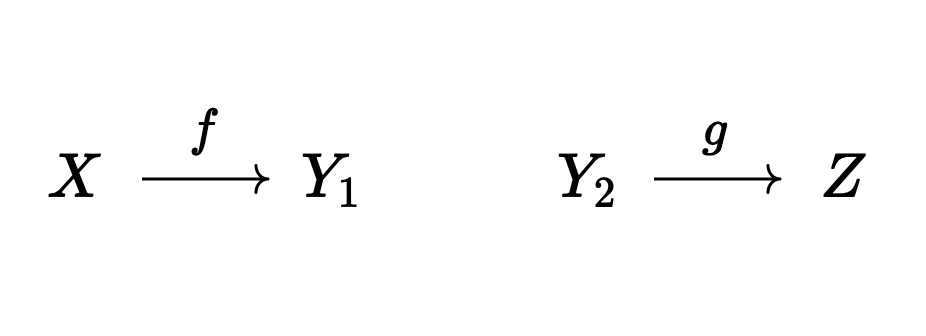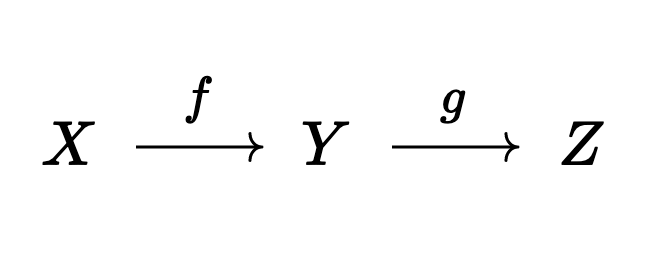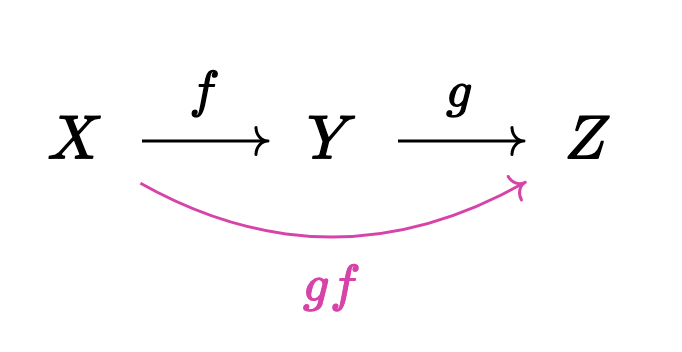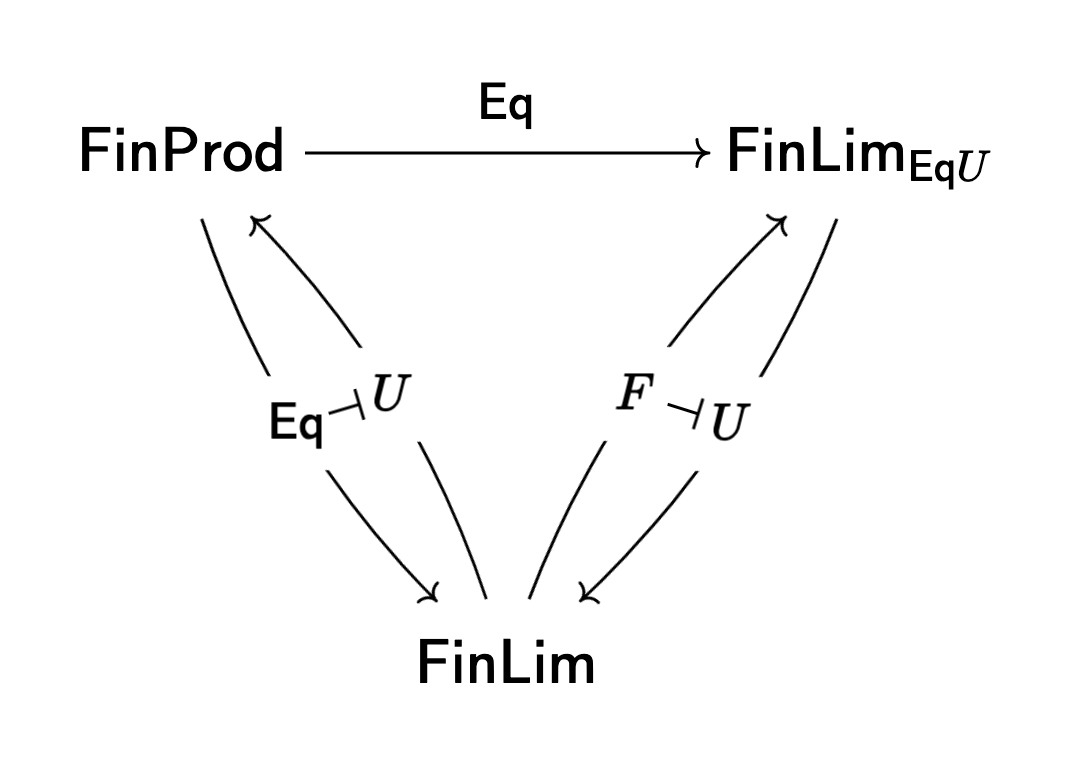Talk -- 2-Categorical Descent and (Essentially) Algebraic Theories
14 Nov 2023 - Tags: my-talks
A few weeks ago I gave a talk at the CT Octoberfest 2023 about some work I did over the summer that I’m really proud of. Unfortunately, while writing up the result I found a 1999 paper by Pedicchio and Wood that proves the same theorem (with roughly the same proof), so I wasn’t able to publish. Thankfully, the work is still extremely interesting, and I was more than happy to talk about it at a little online conference for other category theorists ^_^.
Recall an algebraic theory is something like groups, rings, modules,
etc. It’s a structure that can be defined as a set (or possibly multiple sets)
with some operations defined on it (allowing constants as
An essentially algebraic theory is something like categories. It’s a structure that can be defined as a set (or possibly multiple sets) with some operations defined on it, etc. The main superpower we get in the essentially algebraic world over the algebraic one is partially defined functions. Now our operations don’t have to be defined everywhere, they are allowed to be defined on subsets of the sorts. As long as those subsets are definable by equations!
For instance, the theory of categories is essentially algebraic since we have
- Sets
- operations
- an operation
- an operation
- satisfying certain equational axioms, like
Notice that composition isn’t defined on the whole set
Contrast this with fields, which have a partially defined inverse operation
Now, essentially algebraic theories are extremely nice, for lots of reasons I outlined in my talk (and mentioned on the nlab page I linked earlier), but they’re not quite as nice as honest algebraic theories.
For instance, the underlying set of a quotient of groups is a quotient
of the underlying set. If we have a surjection
This is no longer the case for models of an essentially algebraic theory! That is, the underlying set of a quotient might not be a quotient of the underlying set3.
For example, consider the following category:

Notice its set of arrows (ignoring identities) is
Now if we quotient to set

But now that

So after quotienting, our underlying set of arrows (again, ignoring identities) is
Another reason to care about algebraic theories over essentially algebraic
ones is that algebraic theories can be interpreted in any finite product
category, while essentailly algebraic theories make use of all finite limts!
This shows up even for “real mathematicians”, since the category
With this in mind, it’s natural to ask when we can recognize an algebraic theory amongst the essentially algebraic ones. It turns out we can, and the process requires a fair amount of category theory!
We’ve already touched on the relationship between
But it turns out the relationship goes much deeper! Indeed, one can show
that the “sets” in the above bullets actually represent
Given a finite product (resp. finite limit) category
In fact, we can go further! Given a finite product (resp. finite limit) categories
Conversely, given a category of models for some (essentially) algebraic theory,
its category of (
It’s then not so hard to show that these operations are mutually inverse6!
Now if we have an algebraic theory
To view this as an essentially algebraic theory, we want to find a
finite limit category
where
This makes it clear that
With this in mind, we see how to rephrase our problem of recognizing the algebraic theories among the essentially algebraic ones!
Fix an essentially algebraic theory
Then
This means if we want to recognize the algebraic theories, we just need a way to recognize the essential image of the equalizer completion functor!
Thankfully, there’s a very heavy hammer we can use to understand the image of a left adjoint: Comonadic Descent!
I don’t want to say too much about (co)monadic descent here, mainly because I’m going to a friend’s concert tonight and I’ve already written quite a lot about it in my recent preprint. But here’s the short story. We have a diagram of categories

where
The adjunction
It turns out to not be too hard to prove that this adjunction is comonadic by using Beck’s famed (Co)monadicity Theorem! This comes down to some combinatorics7 involving Pitt’s explicit construction of the equalizer completion, first published in Bunge and Carboni’s The Symmetric Topos, which solves our problem!
Pedicchio and Wood, in their ‘99 paper
A Simple Characterization of Theories of Varieties, give a nice
characterization of the image of
Let me say a quick word about the “2-categorical” in the title. In the
last section, to make use of the descent machinery, we had to work with
1-categories
I was kind of hoping that someone would ask about this during the talk – after all I put “2-categorical” in the title, but didn’t mention 2-categories at all! But my talk was the first talk of the day9, so it makes sense that people would have been nice and not asked that.
Regardless, I’m pretty sure an australian would have a reference for this kind of descent (and I might ask about it in the category theory zulip after posting this), because there’s no way I’m the first person to want to use it!
All in all, I’m happy with how the talk went. It was one of the shorter talks I’ve given, and I wanted to assume the audience didn’t know a ton of logic. I think I did a good job giving the flavor of the theorem, and some reasons to care about it, without necessarily getting bogged down in the details of the proof. Hopefully I didn’t come off as too upset that I was 24 years late to publish it myself!
As usual, here’s a copy of the slides, abstract, and recording. I’ll also encourage people to take a look at some of the other talks from the conference (which you can find here). There were a ton of interesting ones10 and if you like category theory I’m sure you’ll find something you enjoy!
Thanks again for reading. Stay warm, and try not to let the November darkness weigh on you too much! Talk soon ^_^
An essentially algebraic theory is an algebraic theory that moreover allows certain partially defined operations. Since algebraic theories enjoy certain nice properties that essentially algebraic theories don’t, it’s natural to ask if we can recognize when an essentially algebraic theory is actually algebraic. In the language of functorial semantics, this amounts to recognizing when a finite limit category is the free completion of a finite product category, and the problem can be solved by considering a 2-categorical descent theory. This was independent work, but writing it up I learned that the same result can already be found in a 1999 paper of Pedicchio and Wood. This seems to be less well known than it should be, and I hope this talk brings attention to this fascinating subject.
The slides are here, and a recording is below:
-
In fact, we can prove this with category theory! It’s a theorem that the category of all models for an essentially algebraic theory has an initial object. But there isn’t an initial object in the category of fields! So no matter how clever we are, there won’t be an essentially algebraic axiomatization of fields. ↩
-
In fact there’s much more to be said here. The equivalence relation
-
This should be believable for a few reasons. Indeed, the “underlying set” functor is a right adjoint, so we shouldn’t expect it to play nicely with any kind of colimit (like a quotient).
Moreover,
-
If you haven’t seen them before, it may come as a surprise that “real mathematicians” care about lie groupoids, since they sound quite abstract. But they’re really not esoteric at all! They model orbifolds, which are manifolds with certain mild singularities. They arise incredibly naturally when studying, say, manifolds with a group action. ↩
-
This is the slightest of fibs. The situation for finite product categories is actually slightly more sublte than I’m letting on, basically because a finite product category might not be cauchy complete. If you know you know, if you don’t, then trust me that it doesn’t really matter. If you’re interested in the details, you can find them in Adámek, Vitale, and Rosický’s book Algebraic Theories. ↩
-
But they’re only mutually inverse up to equivalence! If we start with a finite limit category
In particular, we don’t get something isomorphic to
What matters is that there’s something honestly 2-categorical happening here, and we need that language to make this notion of “sameness” precise in the same way we need 1-categories to make the notion of “isomorphism” precise. I’m literally so close to finishing a blog post on “2-categories and why you should care” that goes into this in more depth, but I wanted to say a word about it here. After all, rambling footnotes are a feature of this blog! ↩
-
As many theorems do, at the end of the day. Thankfully our combinatorics is also pretty polite. ↩
-
Though they work with the opposite of the categories we work with, so for us they’re more likely to be “effective injectives” after dualizing. ↩
-
Which put it at 6am my time… Thankfully I’ve recently become a morning person, so I only had to wake up an hour earlier than usual. ↩
-
And I haven’t even had time to watch them all yet! ↩